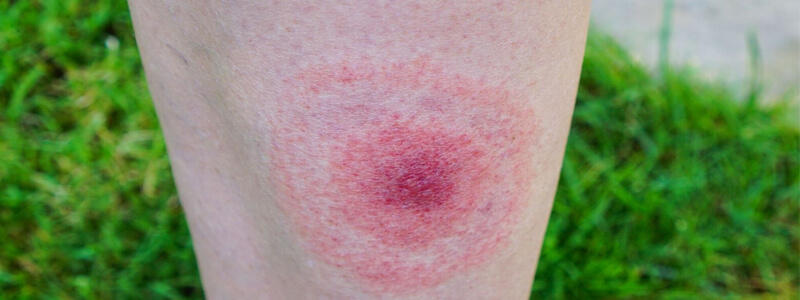A 67-year-old woman comes to see you at the local walk-in centre with a rash on her left forearm. She has a past medical history of hypertension, which is usually well controlled on amlodipine 5 mg od. She feels well in herself today, but her arm feels a little sore. She reports feeling a little shivery over the last 2 days. One week ago she was walking with friends in a local park, in an area of long grass, and thinks she saw a tick on her arm.
When you examine her, she is apyrexial, her blood pressure is 139/92, her oxygen sats are 98% on room air and she has normal heart sounds, with a heart rate of 88bpm regular. Her chest is clear to auscultation. Her left forearm has a ring-like rash on it, with a central lesion that would be consistent with an insect bite.
1. What is the most likely diagnosis?
Show Answer
This patient has contracted Lyme disease.
Lyme disease is an infectious disease caused by the bacterium Borrelia burgdorferi. It is transmitted to humans via ticks that are infected with Borrelia burgdorferi. The number of cases in the UK is increasing; confirmed serological cases have tripled since 2003. It is likely that many more cases occur and are not detected clinically.
Animals that the ticks commonly occur on in the UK include sheep, deer, hedgehogs, foxes and badgers. Ticks can also be deposited in long grass as these animals travel through them. Common areas where tick bites occur include urban parklands and areas with long grasses.
Sensible clothing can reduce the risk of a tick bite. Sturdy footwear, trousers and long sleeves can help transmission, together with vigilance for the presence of any ticks. If a tick is seen on the skin, it should be removed promptly, with the aim of removing it whole. The tick often has to be attached for up to 24 hours before transmission occurs; so early removal can hugely decrease the risk of Lyme disease.
Diagnosis, particularly in the early stages, is usually through history alone. Where there is diagnostic doubt, antibodies to Borrelia burgdorferi can be tested for, although this has a high false negative detection rate in the early stages of the disease, so may need to be repeated.
2. What is the name of the rash?
Show Answer
This is the classical erythema chronicum migrans rash of Lyme disease.
Following a bite from an infected tick, there is an incubation period of 2 days to 14 weeks. Initial common symptoms include a flu-like illness with fatigue, myalgia, gastrointestinal upset, headaches and arthralgia.
The rash that is characteristically associated with Lyme disease is called erythema migrans and appears as an expanding ring lesion around the tick bite. The leading edge is usually erythematous, with the central area often being paler in colouration.
An example of the rash can be seen below:
3. How is this disease best treated?
Show Answer
Treatment is best managed by an expert in Lyme disease. Oral antibiotics that are commonly used include doxycyline 100mg bd for 2 weeks or amoxicillin 500mg tds for 2 weeks. If these are both contraindicated, cefuroxime 500mg bd for 2 weeks can be used instead.
If there is any doubt about the diagnosis, expertise should be sought from an infectious disease specialist.
4. List some of the complications that can occur.
Show Answer
Lyme disease can affect many different systems of the body if untreated. These include:
- Neurological system: facial nerve palsies (may be unilateral or bilateral),
- Meningitis, encephalitis, Bannwarth’s syndrome, vertigo
- Cardiovascular system: myopericarditis
- Haematological system: lymphocytomas (blue/red nodules)
- Musculoskeletal system: arthritis
- Skin: acrodermatitis chronica atrophicans (rare – can occur years later on extensor surfaces of limbs)
- General: symptoms similar to chronic fatigue syndrome, also known as ‘Post-Lyme syndrome’
Header image used on licence from Shutterstock






